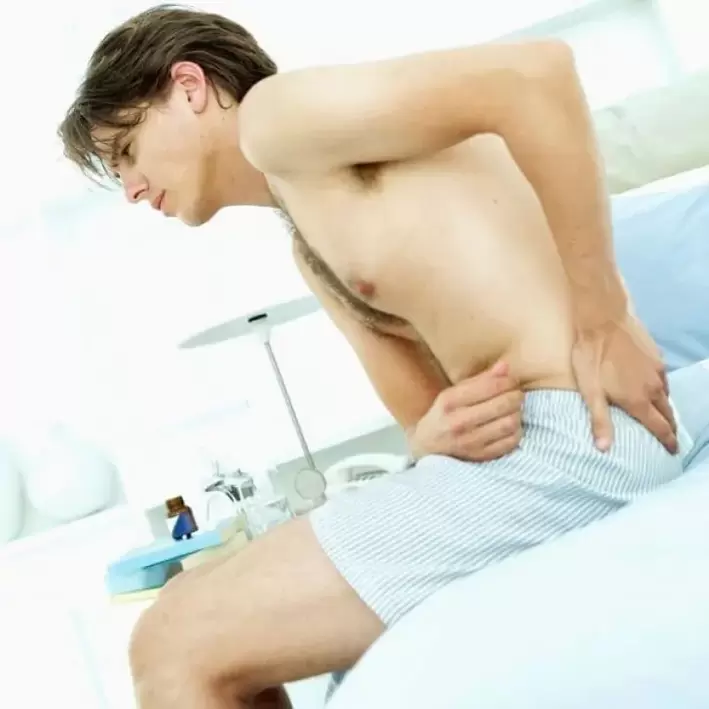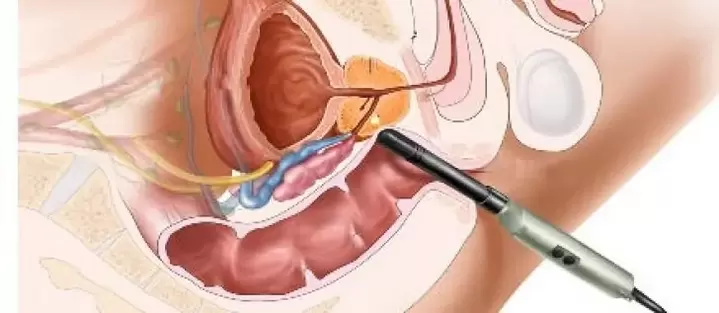
Chronic prostatitis is a serious problem. Even modern urology is unable to answer many questions about this pathology. Experts believe that chronic prostatitis is a disease caused by a number of health problems that include tissue damage as well as dysfunction not only of the urinary tract and prostate gland but also other organs.
The pathology is diagnosed mainly in men of reproductive age. Chronic prostatitis in older men is often accompanied by benign neoplasms of the prostate.
Classification of the disease
The classification of prostatitis was developed by scientists at the US National Institutes of Health in 1995:
%20and%20chronic%20inflammatory%20prostatitis%20(right).webp)
- 1 type- Acute bacterial prostatitis. It is diagnosed in 5% of cases of inflammation of the prostate gland.
- Type 2- Bacterial chronic prostatitis.
- 3 types- Chronic bacterial prostatitis. This pathology has another name - Chronic Pelvic Pain Syndrome.
- Type 3A- Inflammatory form of chronic prostatitis. It is diagnosed in 60% of cases of chronic prostatitis.
- Type 3B- Non-inflammatory form of chronic prostatitis. Diagnosed in 30% of cases.
- 4 types- Asymptomatic prostatitis.
There is also a classification of chronic prostatitis compiled in 1990.
Symptoms of chronic prostatitis
Feelings of discomfort and pain in the pelvis that last for more than 3 months are the main symptoms of chronic prostatitis.
In addition, urinary disorders and erectile dysfunction are noted:
- The pain occurs in the perineum, may spread to the anus, groin, inner thigh, sacrum, lower back, and scrotum. Pain on the one hand that extends to the testicles is often not a symptom of chronic prostatitis;
- An erection does not occur despite the presence of adequate conditions, but complete impotence is not observed;
- Premature ejaculation is observed in the early stages of the disease;
- Frequent urination, urinary incontinence, pain and burning sensation in the process of emptying the bladder.
The clinical picture may vary depending on the type of chronic prostatitis.
Infectious form:
- Frequent urination at night;
- Pain in the thighs, perineum, penis and rectum, with aggravated movement;
- Painful urination;
- Weak flow of urine.
Specific Infection:
- Mucous discharge from the urethra;
- Symptoms listed above.
Non-infectious prostatitis:
- Severe pain in the perineum;
- Pain in the thighs and head of the penis;
- The pain is exacerbated by forced cessation of sexual intercourse or prolonged absence of intimate life.
ᲛImportant!The disease develops in waves. The symptoms may be weakened or intensified, but their presence clearly indicates the presence of an inflammatory process.
Symptoms may vary according to the stage of development of the pathology.

The following stages of pathology development are distinguished:
- Exudative.The patient experiences pain in the pubis, groin, and scrotum. Frequent urination and discomfort after sexual intercourse. An erection can hurt.
- Alternative.The pain intensifies, is localized in the groin area, in the part of the pelvis, and is given to the sacrum. Urination is accelerated but occurs without difficulty. Erection does not suffer.
- Proliferative.During exacerbation, urination becomes more frequent. Urine flow is weakened.
- Cicatricial.Sclerosis of prostate tissue occurs. There is a feeling of heaviness in the area of the sac and pubis. Frequent urination. Erection is weakened. Ejaculation may not be present at all.
Symptoms may vary depending on the course of the disease, but in any case, they will gradually increase.
Causes of chronic prostatitis
There are many factors that cause chronic prostatitis. The disease occurs under the influence of infectious agents. The patient has hormonal, neurovegetative, immunological and hemodynamic disorders. Influenced by biochemical factors, urinary reflux in the prostate glands, and impaired growth factors responsible for the proliferation of living cells.
Causes that influence the formation of pathology:
- Urinary tract infections;
- Hypodynamics;
- Irregular sex life;
- Continuous catheterization of the bladder;
- Regular hypothermia.
developmentDiseases of bacterial naturePromotes intraprostatic urinary reflux.
Chronic bacterial prostatitisDevelops against the background of neurogenic disorders of the pelvic floor muscles, as well as elements responsible for the functioning of the bladder wall, prostate and urethra.
FormationMyofascial trigger points, Which are located near the genitals and prostate gland, can provoke pelvic pain syndrome. Points caused by certain diseases, surgical interventions, and injuries can cause pain in the groin area, perineum, and surrounding areas.
Diagnosis of pathology
The presence of a complex of symptoms makes it possible to diagnose chronic prostatitis without much difficulty. However, in some cases, the pathology may be asymptomatic. In this case, in addition to the standard examination and interrogation of the patient, additional research methods are needed.Neurological examination and study of the patient's immunological condition is mandatory..
ᲛImportant!Special questionnaires and questionnaires allow you to more accurately identify the patient's subjective feelings and get a complete picture of the state of health, pain intensity, ejaculation, erection and urinary disorders.
Laboratory diagnostics
Laboratory diagnosis makes it possible to distinguish between bacterial and bacterial forms of pathology, as well as to determine the type of pathogen and to make the most accurate diagnosis.Chronic inflammation of the prostate is confirmed when a fourth urine sample or prostate secretion contains more than 10 leukocytes in PZ, or bacterial associations.When the number of leukocytes increases but the bacteria are not sown, the material is examined to detect chlamydia or other STD pathogens.
- The discharge from the urethra is sent to a laboratory to detect the viral, fungal, and bacterial flora, leukocytes, and mucus contained in it.
- Scraping from the urethra is examined by PCR. This allows you to identify sexually transmitted pathological agents.
- Perform a microscopic examination of prostate secretion to count the number of macrophages, leukocytes, amyloid, and truss-laleman bodies. Immunological and bacteriological examination is prescribed. Determine the level of nonspecific antibodies.
- Blood sampling is performed ten days after digital rectal examination to determine the PSA concentration in it. 4. At a rate greater than 0 ng / ml, the patient undergoes a prostate biopsy for oncological exclusion.
The diagnosis is revealed based on the results of the study.
Instrumental diagnostics

A transrectal ultrasound of the gland will help determine the stage and form of the disease. Ultrasound allows you to rule out other diagnoses, monitor the effectiveness of treatment, as well as determine the size of the prostate, its echostructure, the uniformity and density of the seminal vesicles. Urodynamic studies and myography of the pelvic floor muscles allow you to detect infravesal obstruction and neurogenic disorders that often accompany the pathology.
Tomography and MRI are used to make a differential diagnosis, in particular with prostate cancer. These methods will detect abnormalities in the pelvic organs and spinal column.
Differential diagnosis
Differential diagnosis is important because there is a risk that the patient will have a more serious illness.
Differential diagnosis is established with such diseases:
- Pseudodysynergia, functional disorders of the detrusor-sphincter system, bladder dysfunction of neurogenic origin, complex regional pain syndrome;
- Narrowing of the bladder, hypertrophic changes in the neck of the bladder, prostate adenoma;
- Osteoarthritis of the pelvic joint, cystitis;
- Pathology of the rectum.
If symptoms occur, the prostate gland should be examined by a urologist or andrologist.. Get an ultrasound scan. Prostate biopsy is prescribed if necessary.
Methods of treatment of pathology
Chronic prostatitis is treated by a urologist or andrologist. Therapy is conducted in a complex. Correction is subject to the patient's lifestyle, thinking peculiarities and habits. It is important to exercise more, reduce alcohol intake to a minimum, get rid of nicotine addiction, eat right and normalize your sex life. However, doing without a basic therapy course will not work. Taking medication is the main condition for complete recovery.
Indications for hospitalization
Most often the treatment is carried out on an outpatient basis. But in cases where the disease is incurable and has a tendency to recur, the patient is sent to a hospital where treatment is more effective.
Medical method of treatment
This method aims to eliminate the existing infection, normalize blood circulation, improve drainage of the prostate lobes, correct the hormonal background and immune status. Doctors therefore prescribe antibiotics, vasodilators, immunomodulators, anticholinergics, and anti-inflammatory drugs.
If the pathology is bacterial in nature, antibiotics are definitely recommended. The agent is prescribed based on the results of bacterial culture of prostate secretion.This will make it possible to isolate the pathogen by further determining its susceptibility to a particular drug. The effectiveness of treatment with a well-designed scheme reaches more than 90%.
A short course of antibiotics is prescribed in bacterial form. It lasts only if the scheme gives a positive result. The effectiveness of therapy is about 40%
With chronic pelvic pain, the duration of the course of antibiotics is not more than one month. Treatment with positive dynamics lasts another month. If there is no effect, the medication is replaced with another that may be more effective.
Antibacterial agents from the group of fluoroquinolones are the main drugs for the treatment of pathology.They have a high bioavailability, are active against most Gram-negative bacteria, ureaplasmas and chlamydia, accumulate in prostate tissues.
When treatment with fluoroquinolones is ineffective, penicillins may be prescribed.
Antibacterial drugs are used for preventive purposes.
After treatment with antibiotics, therapy with A-blockers is prescribed.This treatment strategy is effective for patients who have persistent obstructive and irritating symptoms.
If urinary incontinence and pain persist, tricyclic antidepressants may be prescribed, which have analgesic action.
With severe urinary disorders, urodynamic examination is performed prior to therapy and is based on the results obtained.
Non-drug therapy
Non-narcotic methods of therapy make it possible to increase the concentration of antibacterial drugs in glandular tissues, but overdose is not recommended.
The following methods are used for this purpose:
- Electrophoresis;
- Laser therapy;
- Phonophoresis;
- Microwave hyperthermia (used transrectally).
Using the latter method, the temperature is selected individually. Temperatures in the range of 39-40 degrees allow you to increase the concentration of the drug in the body, activate the immune system at the cellular level, prevent bacteria, relieve swelling. Increasing the range to 40-45 degrees allows you to achieve a sclerosing and analgesic effect.
Laser and magnetic therapy are used in combination. The effect is similar to the effect of the above methods, but it also has a biostimulatory effect on the body.
Transrectal massage is performed only in the absence of contraindications.

Surgical method
Chronic prostatitis usually does not require surgery. The exceptions are complications that endanger the patient’s health and life. Modern surgical treatment allows the use of endoscopic surgery. It is minimally invasive. Rehabilitation is faster and minimal damage to the body.
Surgical method is prescribed:
- Prostate sclerosis;
- Prostate adenoma;
- Testicular tuberculosis sclerosis;
- Calcification in the prostate.
ᲛImportant!Surgery is contraindicated in the acute stage. Surgical treatment is prescribed by the surgeon based on the results of the examination and the overall clinical picture.
Prognosis of chronic prostatitis
Doctors are careful to predict the outcome of the disease. It is rare to achieve complete recovery. Basically, chronic prostatitis goes into a stage of prolonged remission. The symptoms disappear, the amount of urine and blood returns to normal. In order not to activate chronic prostatitis and cause complications, it is necessary to follow all the recommendations of a specialist.



























